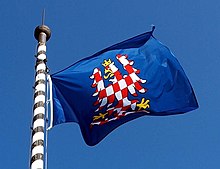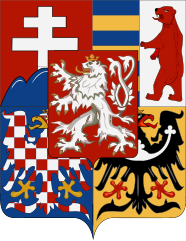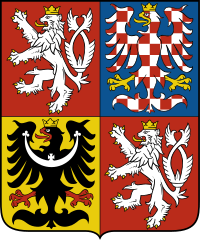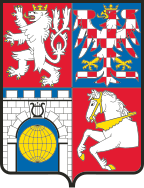
Moravia is a historical region in the east of the Czech Republic and one of three historical Czech lands, with Bohemia and Czech Silesia.
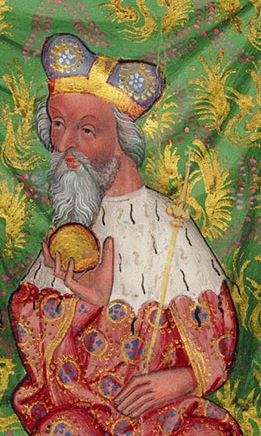
Jobst of Moravia, a member of the House of Luxembourg, was Margrave of Moravia from 1375, Duke of Luxembourg and Elector of Brandenburg from 1388 as well as elected King of Germany from 1410 until his death. Jobst was an ambitious and versatile ruler, who in the early 15th century dominated the ongoing struggles within the Luxembourg dynasty and around the German throne.
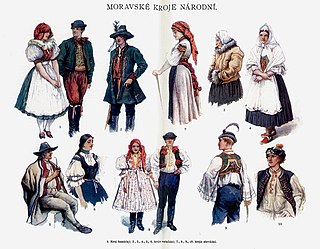
Moravians are a West Slavic ethnographic group from the Moravia region of the Czech Republic, who speak the Moravian dialects of Czech or Common Czech or a mixed form of both. Along with the Silesians of the Czech Republic, a part of the population to identify ethnically as Moravian has registered in Czech censuses since 1991. The figure has fluctuated and in the 2011 census, 6.01% of the Czech population declared Moravian as their ethnicity. Smaller pockets of people declaring Moravian ethnicity are also native to neighboring Slovakia.

The Czech lands or the Bohemian lands is a historical-geographical term that, in a historical context, refers the three historical regions of Bohemia, Moravia, and Czech Silesia together before Czechoslovakia and later the Czech Republic were formed. Together the three have formed the Czech part of Czechoslovakia since 1918 and the Czech Republic since 1 January 1993.

The flag of the Czech Republic is the same as the flag of the former Czechoslovakia. Upon the dissolution of Czechoslovakia in December 1992, the Czech Republic kept the Czechoslovak flag while Slovakia adopted its own flag. The first flag of Czechoslovakia was based on the flag of Bohemia and was white over red. This was almost identical to the flag of Poland, so a blue triangle was added at the hoist in 1920. The flag was banned by the Nazis in 1939 as they established a government nominally in control of Bohemia and Moravia, and a horizontal tricolour of white, red, and blue was used for the duration of the war. The 1920–1939 flag was restored in 1945.

Vladislaus Henry, a member of the Přemyslid dynasty, was elected Duke of Bohemia in 1197 and Margrave of Moravia from 1197 until his death. He only served as duke during the year 1197 and was indeed the last ruler of Bohemia to hold that title. It was his brother Ottokar I, whose forces overthrew him, who finally achieved the elevation of the Duchy of Bohemia to the status of a kingdom starting in 1198.

Henry Bretislav, a member of the Přemyslid dynasty, was Bishop of Prague from 1182, then Duke of Bohemia as "Bretislav III" from 1193 to his death.
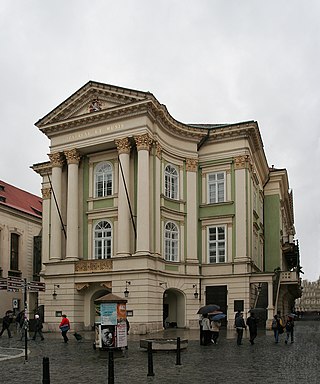
There are ten opera houses in the Czech Republic. The most important are the two opera houses in Prague - National Theatre (Prague) and Prague State Opera.

The flag of Bohemia is a historic flag, which now forms part of the design in the modern flag of the Czech Republic. The flag, a horizontal bicolour, was based on the colours of the former monarchs of Bohemia.

The coat of arms of the Czech Republic is divided into two principal variants. Greater coat of arms displays the three historical regions—the Czech lands—which make up the nation. Lesser coat of arms displays lone silver double-tailed lion in red shield. The current coats of arms, which was adopted in 1992, was designed by Czech heraldist Jiří Louda.

The House of Zierotin or House of Žerotín was a Czech noble family in the Lands of the Bohemian Crown, one of the oldest and most illustrious noble families from Bohemia and Moravia. The family was first mentioned around the year 1200 as Bludovici, later renamed Žerotínové, and achieved the rank of Imperial Counts in the Holy Roman Empire. The male line of this family died out in 1985. Its estates, manor Bludov, were returned to their female descendants, the family Mornstein-Zierotin after fall of Communist rule in 1989.

The coat of arms of Czechoslovakia were changed many times during Czechoslovakia’s history, some alongside each other. This reflects the turbulent history of the country and a wish to use appropriate territorial coats of arms.
The Czechoslovak First League was the premier football league in the Czechoslovakia from 1925 to 1993, with the exception of World War II. Czechoslovakia was occupied by German forces who formed Gauliga Sudetenland and Gauliga Böhmen und Mähren leagues on occupied territories. Until the 1934-35 season, no teams from Slovakia participated in the league.

Moravian dialects are the varieties of Czech spoken in Moravia, a historical region in the east of the Czech Republic. There are more forms of the Czech language used in Moravia than in the rest of the Czech Republic. The main four groups of dialects are the Bohemian-Moravian group, the Central Moravian group, the Eastern Moravian group and the Lach (Silesian) group. While the forms are generally viewed as regional variants of Czech, some Moravians claim them to be one separate Moravian language.

The Margraviate of Moravia was one of the Lands of the Bohemian Crown within the Holy Roman Empire and then Austria-Hungary, existing from 1182 to 1918. It was officially administered by a margrave in cooperation with a provincial diet. It was variously a de facto independent state, and also subject to the Duchy, later the Kingdom of Bohemia. It comprised the historical region called Moravia, which lies within the present-day Czech Republic.

An official appearance of the flag of Moravia, unlike the provincial Moravian coat of arms, does not exist, because such a flag has never been granted to Moravia. However, there are several documented variants of Moravian flags used in the past. The first recorded version dates from the mid-13th century.

Ulrich I, Duke of Brno was the Duke of Moravia for twenty one years - between 1092 and 1113. He was the first son and successor of Conrad I, Duke of Bohemia and Wirpirk of Tengling. He did not succeed as half ruler of Moravia (diarch), for all half of Moravia as his father Conrad I, but Brno was divided into two parts: Brno and Znojmo and Ulrich was co-ruler in this part with his brother Luitpold of Znojmo. Both brothers together established a benedictine cloister and its St. Procopius Basilica in Třebíč and prepared as mausoleum for Brno-Znojmo branch House of Přemyslid.

Luitpold of Znojmo was a Bohemian nobleman and a member of the Přemyslid dynasty who was the Duke of Znojmo in Moravia for twenty years, from 1092 until his death.

Moravian cuisine encompasses the cooking styles, traditions and recipes associated with Moravia, a region of the Czech Republic and historically belongs to the Moravia, former historical country in Central Europe. Today, it is often perceived as an integral part of Czech cuisine, to which it has over the last century been artificially accommodated and mixed. Nevertheless, there is a large list of dishes, drinks and customs that are original only for Moravia.
William Zajíc of Valdek and Židlochovice was a Bohemian nobleman and politician.

